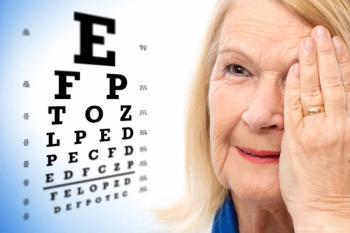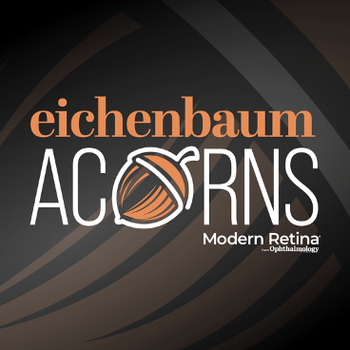
Researchers identify biomarkers for selecting AMD patients for TES protocol
Researchers from South Korea have validated the TES protocol through the identification of OCT-A biomarkers that correspond with recurrent sustained exudation choroidal neovascularization (CNV).
In age-related macular degeneration (AMD), treat-and-extend regimens, along with the treat-extend-stop (TES) protocol, have shown comparable efficacy to fixed dosing.
Now, researchers from South Korea have validated the TES protocol through the identification of OCT-A biomarkers that correspond with recurrent sustained exudation choroidal neovascularization (CNV). These findings confirm that discontinuing treatment is possible in certain patients with neovascular AMD if CNV is not observed on OCT-A after anti-VEGF treatment, said Kunho Bae, MD, et al.1
Study design and results
A total of 128 patients (134 eyes) with neovascular AMD were enrolled and split into two groups: stop treatment (n = 44) and continuing treatment (n = 90).
To be enrolled in the stop treatment group, patients must have met the TES criteria for treatment cessation. In this study, the TES protocol encompassed the following: after 3 injections at 4-week intervals, the treatment period was extended if the macula was determined to be without fluid on OCT and clinical examination.
As soon as the macula was free of fluid, the treatment intervals were increased successively by 2 weeks until 12 weeks had passed. Patients then received 2 or more injections at 12-week intervals, and if the macula remained dry, treatments were suspended and the patients were monitored carefully.
Mean age across the study was 73.8 years (range, 54-92), and the majority of patients were male (62%). Additional baseline clinical characteristics are outlined in the Table.
OCT-A images were assessed at least 24 months after anti-VEGF treatment began, when the CNV lesion was stable. Bae et al. used OCT-A to identify CNV lesions through known patterns and forms: closed circuit, open circuit, peripheral loop, and capillary fringe.
Closed circuit was defined as the “presence of anastomotic vessel bounding the outer border of the vascular lesion for more than 50% of the entire CNV margin,” open circuit was defined as “anastomotic vessel for less than 50%,” peripheral loop was defined as “looping vessels in the periphery branching into vascular arcades between the vessel termini,” and capillary fringe was defined as “fine peripheral network or flush of vessels that were not individually resolved on OCTA.”
In the continuing treatment group, 37% of eyes had open-circuit patterns on the OCT-A, while 63% of eyes had closed-circuit patterns. In the stop group, 78% of eyes had open-circuit patterns, while only 22% of eyes had closed. CNV was not observed in 17 eyes in the stop treatment group. CNV patterns varied greatly across both groups. Capillary fringe and peripheral loop patterns were more common in the continuing treatment group than stop group (73.3% versus 45.4%, p = 0.002, and 88.7% versus. 11.3%, p < 0.001, respectively) and were associated with sustained neovascular activity.
Based on these observations, researchers concluded that the appearance of neovascularization can be used to determine if patients with neovascular AMD will respond to anti-VEGF therapy. They also concluded that TES is reasonable and discontinuing treatment possible.
Clinical Impact
Although it’s understood when to start treatment for AMD, there are no set guidelines for discontinuing treatment, the authors said. The burden on patients and their caregivers’ quality of life cannot be understated, the authors added; in addition to financial strain, patients also face loss of productivity in time away from work and personal responsibites.2,3
The TES protocol is modified version of the treat-and-extend protocol4,5; treatment continues until the patient is dry, then stops. The authors said two types of treatment response to TES may be expected, depending upon morphologic patterns on OCT-A.
“Our findings have two main consequences: first, confirming the validity of TES regimens and promoting the possibility of discontinuing treatment, and second, verifying the morphologic pattern of CNV on OCTA after anti-VEGF treatment as a useful biomarker determining whether to stop anti-VEGF injection or to continue disease suppression by maintenance therapy,” they said.1
By analyzing these patterns of neovascularization and other morphologic features, clinicians may be able to provide better individualized follow-up treatment of wet AMD, the authors concluded.
References:
Bae K, Kim HJ, Shin YK, Kang SW. Predictors of neovascular activity during neovascular age-related macular degeneration treatment based on optical coherence tomography angiography. Scientific reports 2019;9:19240.
2. Brown GC, Brown MM, Sharma S, et al. The burden of age-related macular degeneration: a value-based medicine analysis. Trans Am Ophthalmol Soc 2005;103:173-84; discussion 184-6.
3. Prenner JL, Halperin LS, Rycroft C, Hogue S, Williams Liu Z, Seibert R. Disease Burden in the Treatment of Age-Related Macular Degeneration: Findings From a Time-and-Motion Study. Am J Ophthalmol 2015;160:725-31.e1.
4. Arnold JJ, Campain A, Barthelmes D, et al. Two-year outcomes of "treat and extend" intravitreal therapy for neovascular age-related macular degeneration. Ophthalmology 2015;122:1212-9.
5. Adrean SD, Chaili S, Ramkumar H, Pirouz A, Grant S. Consistent Long-Term Therapy of Neovascular Age-Related Macular Degeneration Managed by 50 or More Anti-VEGF Injections Using a Treat-Extend-Stop Protocol. Ophthalmology 2018;125:1047-1053.
Newsletter
Keep your retina practice on the forefront—subscribe for expert analysis and emerging trends in retinal disease management.




